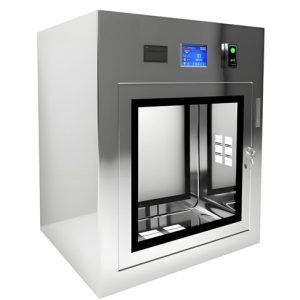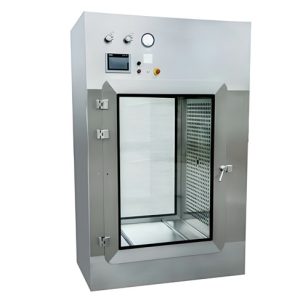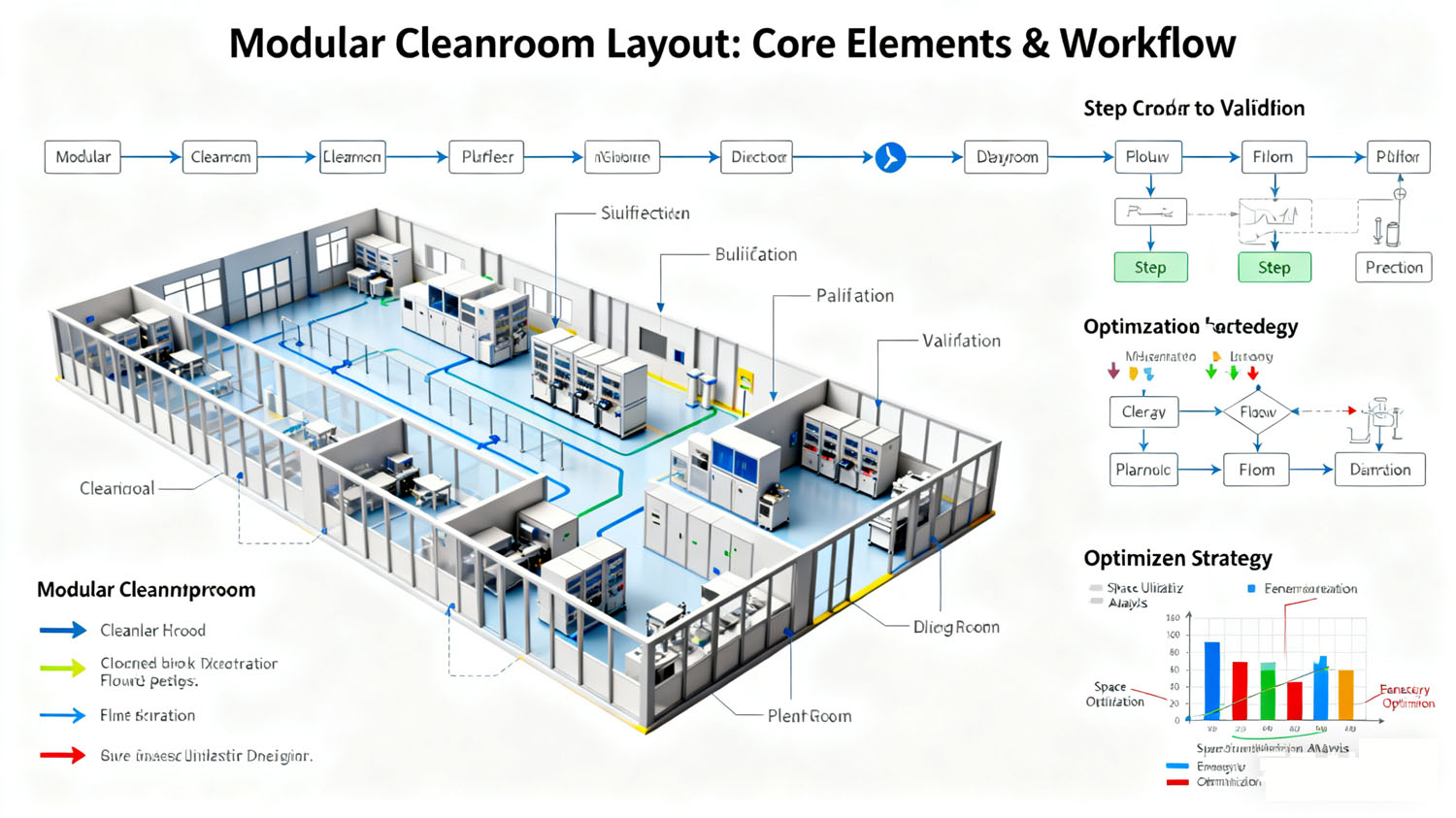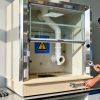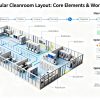Account
-
Safe payment options
We only work with the most secure payment systems.
-
Product return within 30 days
We do our very best to keep our customers happy.
No products in the cart.
You dont have any products in your cart yet, add a few products to experience this experience.
Add $500.00 to cart and get free shipping!
To see and take advantage of all discounted products.
Click HereModular Cleanroom Layout Design: Key Principles, Steps, and Optimization Strategies
Table of Contents
Introduction
Effective modular cleanroom layout design plays a crucial role in manufacturing efficiency, product quality, and regulatory compliance across industries like pharmaceuticals, microelectronics, and biotechnology. A well-planned modular cleanroom layout design can reduce contamination risks by up to 85% compared to traditional facilities, while offering significant advantages in flexibility, rapid deployment, and scalability.
This comprehensive guide provides a complete framework for modular cleanroom layout design, from initial concept through final implementation. We’ll explore the fundamental principles, systematic design steps, and optimization strategies that ensure your modular cleanroom layout design meets both current operational needs and future expansion requirements.
Understanding Modular Cleanroom Basics
Modular cleanrooms consist of prefabricated components that offer significant advantages over traditional construction. The key elements include insulated wall panels (typically 50mm-100mm thickness), fan filter units (FFUs) with HEPA/ULPA filtration, suspended ceiling grids, anti-static vinyl flooring, and specialized doors/windows with airtight seals.
These standardized components enable rapid assembly and reconfiguration. For example, a typical Deiiang™ modular cleanroom can be installed 40-60% faster than conventional construction. The modular approach allows for precise control over environmental parameters, with temperature maintained at 21±2°C, humidity at 45±5% RH, and pressure differentials between zones typically at 10-15 Pascals.
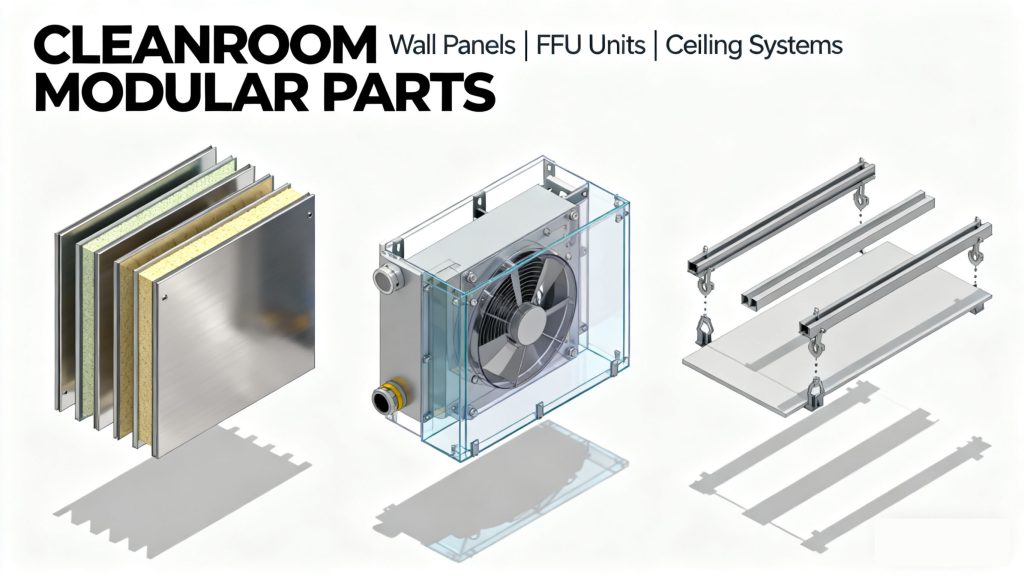
Figure: Key components of a modular cleanroom system
Fundamental Principles of Cleanroom Layout Design
Successful modular cleanroom layout design requires adherence to several core principles that ensure contamination control and operational efficiency. These principles form the foundation of any effective cleanroom environment regardless of industry application.
3.1 Unidirectional Flow Principle
Personnel and materials should follow a predetermined path from lower to higher cleanliness areas, preventing cross-contamination. For example, in pharmaceutical applications, personnel typically follow this sequence: entrance → gowning area (ISO 8) → airlock → main clean area (ISO 7) → core process area (ISO 5).
3.2 Cleanliness Zoning/Grading
Areas should be classified according to required cleanliness levels (ISO 5 to ISO 8), with proper isolation between zones. A typical electronics cleanroom might have ISO 7 for assembly areas and ISO 5 for critical processes, separated by airlocks maintaining 15 Pa pressure differential.
3.3 Pressure Differential
Higher cleanliness areas must maintain positive pressure relative to adjacent less-clean areas. The standard pressure cascade is typically: ISO 5 > ISO 6 > ISO 7 > ISO 8 > non-clean area, with minimum pressure differentials of 10-15 Pa between adjacent zones.
3.4 Maintainability & Cleanability
Design must facilitate easy maintenance and cleaning. This includes providing adequate space for filter replacement (minimum 600mm clearance above ceiling), smooth and non-porous surfaces, and rounded corners (minimum 25mm radius) to prevent particle accumulation.
3.5 Scalability & Flexibility
Modular cleanrooms should accommodate future expansion or reconfiguration. Deiiang™ systems typically allow for 20-30% expansion without structural modifications, with panel connections designed for easy disassembly and reassembly.
3.6 Safety & Emergency
Layout must incorporate safety features including emergency exits, eyewash stations, fire detection systems, and clear evacuation routes. Emergency exits should be located within 30m of any workstation and open outward without special knowledge or effort.

Figure: Unidirectional personnel flow from “dirty” to “clean” areas
Key Steps in Modular Cleanroom Layout Design
The systematic approach to modular cleanroom layout design ensures all critical factors are considered from the beginning. Following these steps methodically reduces the risk of costly redesigns and ensures regulatory compliance while optimizing operational efficiency.
4.1 Phase 1: Requirement Analysis & Goal Setting
Thorough analysis of operational requirements forms the foundation of successful modular cleanroom layout design. Key considerations include:
- Application Purpose: Pharmaceutical (GMP compliance), microelectronics (particle control), biotechnology (microbial control)
- Cleanliness Requirements: ISO Class 5-8 based on process sensitivity
- Process Flow: Sequential operations, batch vs continuous processes
- Equipment Specifications: Dimensions, heat load, utility requirements
- Personnel Requirements: Number of operators, gowning protocols
- Material Flow: Raw material entry, in-process handling, finished goods exit
- Space Constraints: Building dimensions, ceiling height, column locations
- Budget & Timeline: Capital investment, installation schedule
- Future Expansion: 2-5 year growth projections
For example, a pharmaceutical filling line might require ISO 5 for critical zones, ISO 7 for background, and specific temperature control at 21±1°C with 45±5% RH.
4.2 Phase 2: Preliminary Conceptual Layout
Based on requirement analysis, create initial sketches dividing the space into functional zones. A typical 100m² cleanroom might allocate:
- 15% for entrance/gowning area (15m²)
- 10% for material airlock (10m²)
- 60% for main process area (60m²)
- 10% for equipment/service area (10m²)
- 5% for exit/waste handling (5m²)
Initial FFU placement follows the rule of thumb: ISO 5 requires 25-40% ceiling coverage, ISO 7 requires 15-25%, and ISO 8 requires 5-15%.
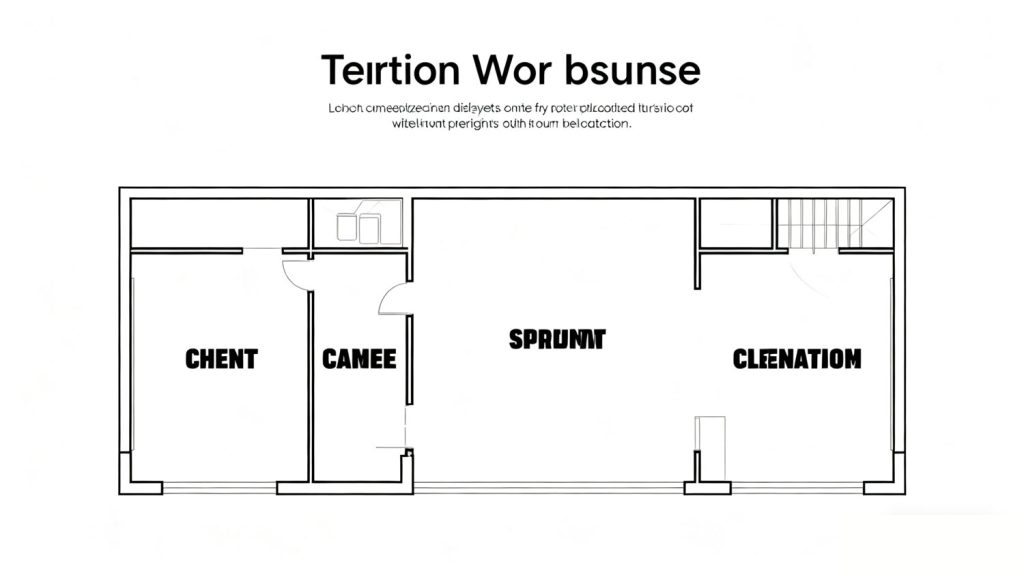
Figure: Preliminary conceptual layout with functional zones
4.3 Phase 3: Detailed Layout Design
This phase transforms the conceptual layout into a detailed, operational design addressing all critical aspects:
Personnel Flow Design
Detailed planning of personnel movement: entrance → locker area → pre-gowning → gowning room → airlock → clean corridor → workstations → exit. Each transition includes appropriate contamination control measures like sticky mats, air showers, or hand sanitation stations.
Material Flow Design
Planning of material movement: receiving → quarantine → decartoning area → pass-through → process area → packaging → finished goods. Critical calculation: pass-through dimensions = largest component + 150mm clearance (minimum 600×600mm).
Equipment Placement
Precise positioning of all equipment with adequate clearances: operational space (minimum 900mm), maintenance access (minimum 600mm), and safety zones. Utility connections planned with 10-15% spare capacity for future modifications.
Cleanliness Zoning & Pressure Control
Defining cleanroom classifications and pressure cascades: ISO 8 (15Pa) → ISO 7 (25Pa) → ISO 5 (40Pa). Airlocks sized for 2-3 personnel (minimum 2m²) with interlocking doors and pressure monitoring.
Airflow Pattern Design
Determining airflow direction, velocity, and distribution. Unidirectional flow for ISO 5 (0.45m/s ±20%), non-unidirectional for ISO 6-8 (20-40 air changes/hour). Return air grilles strategically placed low on walls for optimal particle removal.
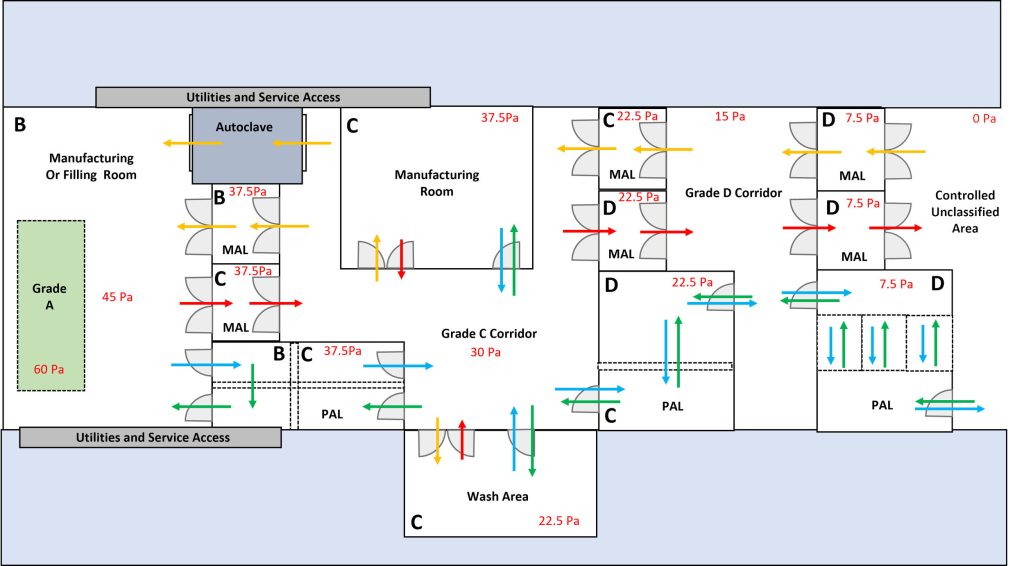
Figure: Detailed layout with personnel flow (blue) and material flow (green)
4.4 Phase 4: 3D Modeling & Visualization
Using CAD/BIM software (AutoCAD, Revit, SolidWorks) to create precise 3D models that identify spatial conflicts, optimize ergonomics, and validate the design. Deiiang™ typically uses BIM for clash detection, reducing construction issues by 70-80%.
4.5 Phase 5: Review, Revision & Final Approval
Comprehensive review with all stakeholders including production, quality control, maintenance, and safety personnel. Typical review checklist includes:
- Regulatory compliance verification
- Operational workflow efficiency
- Maintenance accessibility
- Safety and emergency protocols
- Utility distribution adequacy
- Future expansion capability
Following review, incorporate feedback and obtain formal approval before proceeding to fabrication and installation.
Specific Factors Influencing Layout Design
Several industry-specific and operational factors significantly impact modular cleanroom layout design decisions. Understanding these variables ensures the final design meets both technical and regulatory requirements.
5.1 Process Type & Particle Generation
Wet processes (pharmaceutical compounding) require chemical-resistant surfaces and drainage, while dry processes (electronics assembly) need enhanced ESD protection. High particle-generating operations need increased air changes (up to 60 ACH for ISO 5).
5.2 Product Sensitivity
Products sensitive to temperature (±0.5°C), humidity (±3% RH), or electrostatic discharge require specialized environmental controls and material selection. Pharmaceutical products may need 21±1°C, while electronics might need <40% RH for ESD control.
5.3 Equipment Maintenance Space
Adequate clearance around equipment: front access (minimum 900mm), rear access (minimum 600mm), overhead clearance for filter replacement (minimum 600mm). Large equipment may require removable wall panels for installation.
5.4 Regulatory & Standard Compliance
Industry-specific requirements: cGMP for pharmaceuticals, ISO 14644 for classification, FDA 21 CFR Part 11 for electronic records, and SEMI standards for microelectronics.
5.5 Energy Efficiency & Environmental Control
Optimizing layout to reduce energy consumption: variable air volume systems, heat recovery, efficient equipment placement. Proper design can reduce HVAC energy use by 20-30% compared to conventional approaches.

Process type analysis for determining required cleanliness levels
Figure: Process type analysis for determining required cleanliness levels
Common Modular Cleanroom Layout Configurations
Several standard layout configurations have proven effective for different applications and space constraints. Each offers distinct advantages for specific operational requirements.
6.1 Linear/Straight-line Layout
Process flow follows a straight path from raw material to finished product. Ideal for sequential operations with minimal backtracking.
Advantages: Simple workflow, easy supervision, minimal cross-traffic
Disadvantages: Requires longer space, limited flexibility
Applications: Assembly lines, packaging operations
6.2 U-shaped/L-shaped Layout
Process flow follows a U or L pattern, suitable for space-constrained areas or processes requiring material return.
Advantages: Efficient use of space, compact footprint
Disadvantages: Potential congestion at corners, complex material handling
Applications: Laboratories, research facilities, small-scale production
6.3 Central Island Layout
Core process area in center with support areas surrounding it. Ideal for processes requiring multiple support functions.
Advantages: Excellent supervision, efficient material distribution
Disadvantages: Higher construction cost, potential airflow challenges
Applications: Biotechnology, pharmaceutical compounding, critical processes
| Layout Type | Space Efficiency | Workflow Efficiency | Expansion Potential | Cost Impact |
|---|---|---|---|---|
| Linear/Straight-line | Medium | High | Low | Low |
| U-shaped/L-shaped | High | Medium | Medium | Medium |
| Central Island | Low | High | High | High |
Comparison of different modular cleanroom layout configurations
Design Tools & Best Practices
Utilizing appropriate design tools and following industry best practices significantly improves the quality and efficiency of modular cleanroom layout design projects.
7.1 Common Design Software
- AutoCAD: 2D drafting and detailed drawings
- Revit (BIM): 3D modeling with building information
- SolidWorks: Equipment modeling and integration
- Specialized Cleanroom Software: Computational fluid dynamics for airflow simulation
Deiiang™ typically uses BIM for complex projects, reducing design conflicts by up to 80% compared to traditional 2D approaches.
7.2 Best Practices
- Early Multidisciplinary Integration: Involve production, quality, maintenance, and safety teams from concept stage
- Lifecycle Cost Consideration: Evaluate operational costs (energy, maintenance) alongside capital investment
- Airflow Simulation: Model particle distribution and airflow patterns before construction
- Detailed SOP Development: Create comprehensive standard operating procedures for all operations
- Continuous Validation: Implement ongoing monitoring and periodic requalification
7.3 Common Mistakes to Avoid
- Ignoring personnel and material flow intersections
- Inadequate clearances for maintenance and filter replacement
- Insufficient consideration of future expansion needs
- Over-specifying or under-specifying cleanliness requirements
- Poor placement of utilities and service connections
- Inadequate emergency and safety provisions
According to industry data collected by Jason.peng, approximately 65% of cleanroom design issues stem from inadequate upfront planning and failure to involve all stakeholders early in the process.
Frequently Asked Questions
Can modular cleanroom layouts be easily modified?
Yes, one of the key advantages of modular cleanrooms is their reconfigurability. Deiiang™ systems typically allow for layout changes with minimal disruption, often completed in 30-50% of the time required for traditional construction modifications. Wall panels can be repositioned, and additional modules can be integrated as needed.
How is isolation maintained between different cleanliness zones?
Isolation is achieved through a combination of physical barriers (walls, doors), pressure differentials (typically 10-15 Pa between adjacent zones), and procedural controls (gowning protocols, material transfer procedures). Airlocks with interlocking doors prevent simultaneous opening between zones of different classifications.
How to design a cleanroom layout for small spaces?
For limited spaces, consider vertical utilization with mezzanines, compact equipment layouts, and multi-functional areas. U-shaped or L-shaped configurations often work well. Optimize every square meter by carefully analyzing workflow and eliminating non-value-added movements. Deiiang™ has successfully implemented ISO 5 cleanrooms in spaces as small as 12m².
How is fire safety addressed in cleanroom design?
Fire safety incorporates early detection systems, appropriate fire-rated materials (typically 1-hour rating for walls), emergency lighting, clearly marked exits, and automatic fire suppression systems. Cleanroom-specific considerations include compatibility of fire suppression agents with sensitive equipment and processes.
How to determine the number and placement of FFUs?
FFU quantity is calculated based on room volume, required air changes per hour, and filter efficiency. For ISO 5, typical coverage is 25-40% of ceiling area. Placement considers equipment layout, workflow, and return air locations. CFD analysis can optimize distribution for uniform airflow and particle control.
Conclusion
Effective modular cleanroom layout design requires careful consideration of multiple factors including workflow efficiency, contamination control, regulatory compliance, and future flexibility. By following the systematic approach outlined in this guide – from thorough requirement analysis through detailed design and validation – organizations can create cleanroom environments that support operational excellence while accommodating future growth and changes.
The modular approach offers significant advantages in speed of deployment, adaptability, and lifecycle cost, making it an increasingly popular choice across industries requiring controlled environments. Proper planning and professional design consultation are essential investments that pay dividends throughout the cleanroom’s operational life.
Ready to Start Your Modular Cleanroom Project?
Contact our cleanroom specialists today for a free consultation and customized layout design.
Design Specialist: Jason.peng | Brand: Deiiang™




